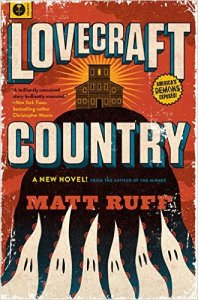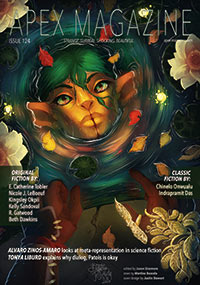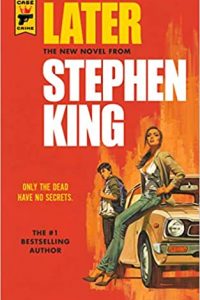Paul Di Filippo reviews Matt Ruff
Lovecraft Country, by Matt Ruff (Harper 978-0-06-229206-3, $26.99, 384pp, hardcover) February 2016
 Consider the name of one of the African-American main characters in Matt Ruff’s heartfelt, passionate, polemical, scary and clever new novel, Lovecraft Country: Atticus Turner. Most literate folks, I believe, will immediately think of Atticus Finch, famous white lawyer from To Kill a Mockingbird. A little cogitation upon “Turner” quickly summons up Nat Turner, rebellious slave and subject of a (still-famous?) novel by William Styron, The Confessions of Nat Turner. Combine the two namesake men, and you get a hybrid being: half-white, half-black; half-concerned with the rule of law, half-transgressive; half-Establishment, half-outsider. In a sense, those two names, yoked together, stimulatingly blend so many contradictions, they embody the disjointed contradictory essence of the USA itself. A useful symbolism indeed for a book that seeks to plumb the depths of our country’s ethical character with regards to racial matters.
Consider the name of one of the African-American main characters in Matt Ruff’s heartfelt, passionate, polemical, scary and clever new novel, Lovecraft Country: Atticus Turner. Most literate folks, I believe, will immediately think of Atticus Finch, famous white lawyer from To Kill a Mockingbird. A little cogitation upon “Turner” quickly summons up Nat Turner, rebellious slave and subject of a (still-famous?) novel by William Styron, The Confessions of Nat Turner. Combine the two namesake men, and you get a hybrid being: half-white, half-black; half-concerned with the rule of law, half-transgressive; half-Establishment, half-outsider. In a sense, those two names, yoked together, stimulatingly blend so many contradictions, they embody the disjointed contradictory essence of the USA itself. A useful symbolism indeed for a book that seeks to plumb the depths of our country’s ethical character with regards to racial matters.
The first section of this novel—and it’s a book cast almost as interrelated short stories, yet with an all-subsuming arc—bears the same title as the whole. We meet Atticus, a Korean-War vet just trying to live his mundane life in 1950s Jim Crow America. Returning to his Chicago roots at the epistolary behest of his disaffected father, Atticus discovers that his dad, Montrose, has been kidnaped and taken away to the mysterious burg of Ardham (not Arkham), Massachusetts, at the behest of a sinister group calling themselves the Adamite Order of the Ancient Dawn, headed by a sorceror named Caleb Braithwhite. With his uncle, George Berry, publisher of the The Safe Negro Travel Guide, and a childhood pal, Letitia Dandridge, Atticus sets out on a cross-country odyssey to rescue his father. What he discovers about America, himself, and the Order is most unsettling—and dangerous.
Part two of the book is titled “Dreams of the Which House” (not “Witch House”) and our POV switches to Letitia, who comes into an inheritance and desires to buy a home in Chicago for herself and sister Ruby. Alas, the Winthrop House proves to contain occult entities that resist her ownership. And discovery of the dead Winthrop’s ties to the Order ramp up the complexities of the current-day plot.
“Abdullah’s Book” finds brothers Montrose and George suborned by a visiting Caleb Braithwhite into retrieving a hidden supernatural tome, in a kind of Night at the Museum caper. George’s wife, Hippolyta, takes center-stage in “Hippolyta Disturbs the Universe,” where her expedition to another world invokes cosmic horror galore. Caleb Braithwhite again appears on the scene to stir the pot by offering Ruby Dandridge the chance to live out an alternate existence, in “Jekyll in Hyde Park.” Again at Caleb’s demands in “The Narrow House,” Montrose and Atticus make a field trip to retrieve more magic books from the heir to the Winthrop clan. “Horace and the Devil Doll” centers around the son of George and Hippolyta, a clever, comic-book-worshipping teenager. (He previously provided a homemade comic that served his Mom as an interstellar map.) And the entire cast is assembled in “The Mark of Cain,” to settle up accounts with Braithwhite and company, with an “Epilogue” to wrap up loose ends.
Now, the obvious demands upon Ruff in such a book are manifold and huge. Primarily, he has to recontextualize Lovecraftian horror along new dimensions—racial prejudice, the lived experiences of American blacks—without utterly destroying HPL’s premises, frissons, and themes. There would be no point in borrowing HPL’s oeuvre if you only wished to accentuate its ridiculousness and absurdities. Lovecraft Country is not some ham-handed book-length satire or parody. This goal Ruff meets admirably. He honors all the tropes and special effects and ambiance of the Mythos in new ways that discard the superficial trappings of the 1920s and HPL’s crotchets for the more relevant clothing and attitudes of the 1950s.
Second, Ruff has to mimetically portray the mundane realities of life for African-Americans of the period, while crafting a vivid and accurate historical novel. This task also he meets with ingenuity, empathy and verve. The emotional and intellectual honesty and authenticity of the lives of his troupe of black characters feels solid and believable, unsparing of both the joys and pains of the period, without verging into simplistic good-and-evil categorizations. Even Caleb Braithwhite earns our sympathies. And about the only anachronism I would adduce is the existence of a stand-alone, dedicated comic-book store in Chicago during this era. Just not a reality, as the Wikipedia entry on the Direct Market reminds us. “Before the direct market [established in the 1970s], most comic books were distributed through newsstands, pharmacies, and candy stores….This practice lasted from the 1930s through the 1960s.”
As he did in his previous novel, The Mirage, which centered on the Moslem world, Ruff thoroughly inhabits a different culture than his own, honoring it and exploring it with the new eyes and respectful heart of any true questing traveler in strange climes. Books like this one prove that the sympathetic imagination of a fine writer is the ultimate toolkit to parse the many different milieus into which human experience can be divided, breaking down all barriers erected by circumstance across our shared heritage.






